TABLE A Comparative Summary Statistics for Transportation and Storage Establishments with Total Employment of 20 and Over: Philippines, 2017 and 2016

Support activities for transportation industry dominates the sector
The preliminary results of the 2017 Annual Survey of Philippine Business and Industry (ASPBI) showed that a total of 1,139 establishments with total employment (TE) of 20 and over in the formal sector of the economy were engaged in transportation and storage activities. This number represents a decrease of 5.2 percent for the year compared with the 1,202 establishments in 2016.
Among the industry groups, support activities for transportation had the most number of establishments of 454 or 39.9 percent of the total. Other land transport followed with 305 establishments or 26.8 percent, while transport via buses ranked third with 159 establishments or 14.0 percent.
Figure 1 illustrates the percentage distribution of the number of establishments with TE of 20 and over for the sector by industry group in 2017.
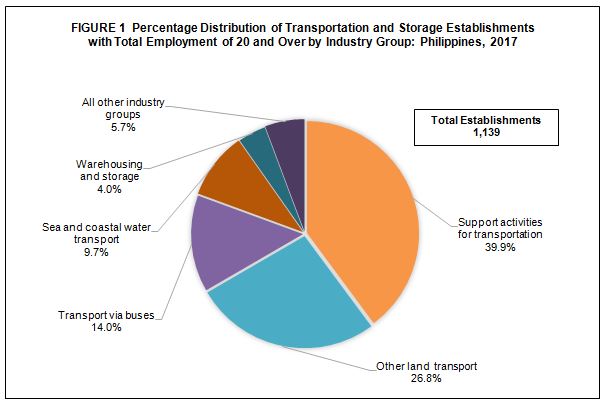
At the regional level, the National Capital Region (NCR) had the highest number of establishments of 626 or 55.0 percent of the total. CALABARZON and Central Visayas followed far behind with 138 establishments (12.1%) and 101 establishments (8.9%), respectively.
Support activities for transportation industry employs the highest number of workers
The total employment of the sector for establishments with TE of 20 and over in 2017 was recorded at 176,870 workers, an increase of 1.0 percent compared with the 175,155 workers in 2016. Of the total employment, 99.3 percent consisted of paid employees and the rest were working owners and unpaid workers.
By industry group, support activities for transportation employed the highest number of workers of 61,549 or 34.8 percent of the total employment. Transport via buses followed with 32,727 workers (18.5%) and sea and coastal water transport with 19,502 workers (11.0%).
The distribution of employment for establishments with TE of 20 and over for the sector by industry group in 2017 is shown in Figure 2.
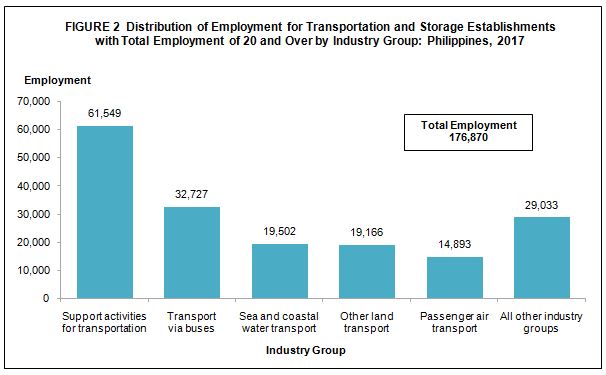
Across the country, the top three regions employed a total of 142,447 workers or 80.5 percent of the total employment for the sector. NCR was the top employer which generated jobs for 115,066 workers (65.1%). This was followed by Central Visayas with 14,303 workers (8.1%) and CALABARZON with 13,078 workers (7.4%).
The sector recorded an average of 155 workers per establishment, higher by 6.2 percent than the reported 146 workers per establishment in 2016. Passenger air transport posted the highest average of 931 workers per establishment. Warehousing and storage, and transport via buses followed with an average of 246 and 206 workers per establishment, respectively.
Employees of passenger air transport industry receive the highest average annual compensation
In 2017, the total compensation paid to employees of the sector for establishments with TE of 20 and over reached PHP61.9 billion, which translates to an average annual compensation of PHP352.2 thousand per paid employee. Compared with the average annual pay of PHP332.3 thousand per paid employee in 2016, the average pay in 2017 increased by 6.0 percent.
The highest average annual compensation of PHP1.2 million was received by employees of passenger air transport. Employees in support activities for transportation, and sea and coastal water transport were the second and third highest earners, receiving an average annual compensation of PHP349.9 thousand and PHP294.8 thousand per paid employee, respectively.
Presented in figure 3 is the average annual compensation of paid employees for the five leading industries of the sector for establishments with TE of 20 and over by industry group in 2017.
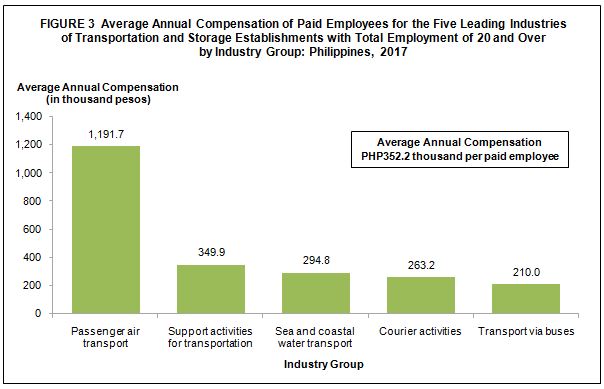
At the regional level, establishments with TE of 20 and over in NCR paid the highest average annual compensation of PHP420.1 thousand per paid employee. This was followed by establishments in Western Visayas and Central Luzon paying PHP348.4 thousand and PHP278.4 thousand per paid employee, respectively.
Passenger air transport industry contributes the biggest share to total income and expense
The total income generated by the sector for establishments with TE of 20 and over in 2017 amounted to PHP548.5 billion, an 0.7 percent increase from the PHP544.6 billion earned in 2016. Passenger air transport activities had the biggest share to total income, amounting to PHP237.7 billion or 43.3 percent.
Among the regions, establishments in NCR earned the highest income of PHP466.5 billion or 85.0 percent of the total. Central Visayas and CALABARZON followed with PHP26.1 billion (4.7%) and PHP20.5 billion (3.7%), respectively.
Meanwhile, the total expense incurred by establishments with TE of 20 and over amounted to PHP483.2 billion in 2017. This figure was higher by 3.7 percent than the PHP466.2 billion reported expense in 2016. Industry-wise, passenger air transport activities incurred the highest expense amounting to PHP230.2 billion or 47.6 percent of the total.
By region, NCR incurred the highest expense of PHP415.8 billion or 86.0 percent of the total expense. Central Visayas and CALABARZON followed with expenses of PHP23.8 billion (4.9%) and PHP14.4 billion (3.0%), respectively.
The income per peso expense generated by the sector for establishments with TE of 20 and over stood at 1.14 in 2017, lower by 2.6 percent from the income per peso expense of 1.17 in 2016. Among industries, support activities for transportation recorded the highest income per peso expense of 1.33. This was followed by sea and coastal water transport with income per peso expense of 1.26.
Among the regions, CALABARZON recorded the highest income per peso expense of 1.43.
Support activities for transportation industry posts the highest value added
The total value added generated by the sector for establishments with TE of 20 and over was estimated at PHP188.9 billion in 2017, a decrease of 1.2 percent compared with the PHP191.2 billion value added in 2016.
The top three contributors to the total value added were the following industries:
- Support activities for transportation, PHP86.6 billion (45.9%)
- Passenger air transport, PHP43.5 billion (23.1%)
- Sea and coastal water transport, PHP26.9 billion (14.2%)
Labor productivity, which is the ratio of value added to total employment, was estimated at PHP1,068.0 thousand per worker in 2017. This figure was lower by 2.2 percent compared with the labor productivity of PHP1,091.5 thousand in 2016.
Passenger air transport registered the highest labor productivity of PHP2,924.0 thousand per worker. This was followed by support activities for transportation, and sea and coastal water transport with PHP1,407.7 thousand and PHP1,376.9 thousand per worker, respectively.
Presented in figure 4 is the labor productivity for the five leading industries of the sector for establishments with TE of 20 and over by industry group in 2017.
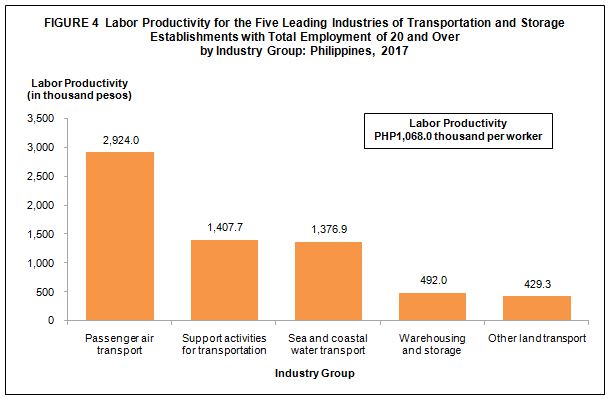
Among the regions, NCR recorded the highest labor productivity which amounted to PHP1,303.6 thousand per worker while Caraga posted the least, with labor productivity of PHP129.7 thousand per worker.
Sales from e-commerce reaches PHP40.2 billion
In 2017, sales from e-commerce transactions of the sector for establishments with TE of 20 and over reached PHP40.2 billion, higher by 40.0 percent compared with the PHP28.7 billion sales in 2016.
Of the total sales from e-commerce, 99.8 percent was recorded from passenger air transport located in NCR.
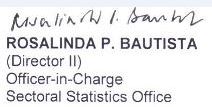
TECHNICAL NOTES
Introduction
This Special Release presents the preliminary results of the 2017 Annual Survey of Philippine Business and Industry (ASPBI) for Transportation and Storage sector for establishments with total employment of 20 and over.
The ASPBI is one of the designated statistical activities of the Philippine Statistics Authority (PSA). Data collected from the survey provide information on the levels, structure, performance, and trends of economic activities of the formal sector in the entire country in2017.
The survey was conducted nationwide in 2018 with 2017 as the reference period of data, except for employment which is as of 15 November 2017.
The Establishment Data Management System (EDMS) was utilized in the decentralized processing of survey returns in the provinces as well as in the online accomplishment of questionnaires through the PSA website.
Data are presented by industry group or 3-digit of the 2009 Philippine Standard Industrial Classification (PSIC) at the national and regional level.
Legal Authority
The conduct of the 2017 ASPBI is authorized under Republic Act 10625, known as the Philippine Statistical Act of 2013, which mandates reorganizing and strengthening of the Philippine Statistical System (PSS), its agencies and instrumentalities.
Scope and Coverage
The 2017 ASPBI covered establishments engaged in 18 economic sectors classified under the 2009 PSIC, namely:
- Agriculture, Forestry and Fishing (A)
- Mining and Quarrying (B)
- Manufacturing (C)
- Electricity, Gas, Steam, and Air Conditioning Supply (D)
- Water Supply; Sewerage, Waste Management and Remediation Activities (E)
- Construction (F)
- Wholesale and Retail Trade;Repair of Motor Vehicles and Motorcycles (G)
- Transportation and Storage (H)
- Accommodation and Food Service Activities (I)
- Information and Communication (J)
- Financial and Insurance Activities (K)
- Real Estate Activities (L)
- Professional, Scientific and Technical Activities (M)
- Administrative and Support Service Activities (N)
- Education (P)
- Human Health and Social Work Activities (Q)
- Arts, Entertainment and Recreation (R)
- Other Service Activities (S)
The survey was confined to the formal sector of the economy, which consists of the following:
- Corporations and partnership
- Cooperatives and foundations
- Single proprietorship with employment of 10 and over
- Single proprietorships with branches
Hence, the 2017 ASPBI covered only the following economic units:
- All establishments with total employment (TE) of 10 or more, and;
- All establishments with TE of less than 10, except those establishments with Legal Organization = 1 (single proprietorship) and Economic Organization = 1 (single establishment), that are engaged in economic activities classified according to the 2009 Philippine Standard Industrial Classification (PSIC).
Frame of Establishments
The frame for the 2017 ASPBI was extracted from the 2017 List of Establishments (LE). The estimated number of establishments in operation in the country in 2017 totaled to 917,582. About 228,112 establishments (24.9%) of the total establishments comprise the establishment frame or are within the scope and coverage of the 2017 ASPBI.
Unit of Enumeration
The unit of enumeration for the 2017 ASPBI is the establishment. An establishment is defined as an economic unit under a single ownership or control which engages in one or predominantly one kind of activity at a single fixed location.
Taxonomy of Establishments
An establishment is categorized by its economic organization, legal organization, industrial classification, employment size, and geographic location.
Economic Organization refers to the organizational structure or role of the establishment in the organization. An establishment may be single establishment, branch, establishment and main office with branches elsewhere, main office only, and ancillary unit other than main office.
Legal Organization refers to the legal form of the economic entity which owns the establishment. An establishment may be single proprietorship, partnership, government corporation, stock corporation, non-stock corporation, and cooperative.
Industrial classification of an economic unit was determined by the activity from which it derives its major income or revenue. The 2009 PSIC which was approved for adoption by government agencies and instrumentalities through NSCB Resolution No. 2 Series 2010 was utilized to classify economic units according to their economic activities.
Size of an establishment is determined by its TE as of a specific date. TE refers to the total number of persons who work in or for the establishment.
This includes paid employees, working owners, unpaid workers and all employees who work full-time or part-time including seasonal workers. Included also are persons on short term leave such as those on sick, vacation or annual leaves and on strike.
Geographic Classification refers to the grouping of establishments by geographic area using the Philippine Standard Geographic Code (PSGC) classification. The PSGC contains the latest updates on the official number of regions, provinces, cities, municipalities, and barangays in the Philippines. The PSGC as of 31 December 2017 was used for the 2017 ASPBI.
Sampling Design
The 2017 ASPBI uses a stratified systematic sampling with 5-digit PSIC serving as industry strata, and employment size as the second stratification variable.
For establishments with TE of 20 and over, the 17 administrative regions serve as the geographic domains while the 5-digit level of the 2009 PSIC serves as the industry domains.
Estimation Procedure for Establishments with TE of 20 and Over
a. Non-Certainty Stratum (strata of TE 20 to 49 and TE 50 to 99) Sections A, C, E, F, G, H, I, J, K, L, M, N, P, Q, R and S.
The estimate of the total of a characteristic  for the non-certainty employment strata in TE of 20 and over for an industry domain in each region,
for the non-certainty employment strata in TE of 20 and over for an industry domain in each region,

where:
s = denotes the non-certainty employment strata in TE 20 to 49 and TE 50 to 99
p = 1, 2,...,17 regions (geographic domains)
xspj = value of the jth establishment in the non-certainty employment strata in TE 20 to 49 and TE 50 to 99for an industry domain in each region
j = 1, 2, 3,…,nsp establishments
Wspj = weight of thejthestablishment in the non-certainty employment strata in TE 20 to 49 and TE 50 to 99 for an industry domain in each region

Nsp = total number of establishments in the non-certainty employment strata in TE 20 to 49 and TE 50 to 99 for an industry domain in each region
nsp = number of sample establishments in the non-certainty employment strata in TE 20 to 49 and TE 50 to 99 for an industry domain in each region
b. Certainty Stratum (Establishments under the following: Section B, D and J, ICT core industries, BPM industries, GOCCs, and with TE 20 and over)
The estimate of the total of a characteristic (X_cp) for the certainty employment stratum in an industry domain in each region,

where:
c = denotes the certainty employment strata in TE of 20 and over
p = 1, 2,..., 17 regions (geographic domains)
xcpj = value of the jth establishment in the certainty employment strata in TE of 20 and over for an industry domain within each region
j = 1, 2, 3, …,mcp establishments
mcp = number of establishments in the certainty employment strata in TE of 20 and over in an industry domain within each region
c. Total Estimate for TE of 20 and Over
The estimate of the total of a characteristic  for the industry domain in each region (geographic domain) is obtained by aggregating the estimates for all employment strata (non-certainty and certainty) in the same industry domain,
for the industry domain in each region (geographic domain) is obtained by aggregating the estimates for all employment strata (non-certainty and certainty) in the same industry domain,

Where d denotes the industry domains and p refers to region.
National level estimates of the characteristics by industry domain were obtained by aggregating separately the estimates  for the particular industry domain from all the regions.
for the particular industry domain from all the regions.
Weight Adjustment Factor for Non-Response
To account for non-response in the non-certainty strata, the adjustment factor (n/n’) was multiplied with the sampling weight (W) of each of the sampling unit. The sampling weight, defined as N/n, was recomputed as

Thus, the adjusted weight (W’spj) for the non-certainty employment stratum for the industry domain with TE 20-99 was

where:
Nsp= total number of establishments in the non-certainty employment stratum with TE 20-99 for the industry domain within each geographic domain (region)
n’sp = number of responding establishments in the non-certainty employment stratum with TE 20-99 for the industry domain within each geographic domain (region)
Response Rate
The response rate for Transportation and Storage establishments with TE of 20 and over was 92.0 percent (705 out of 766 establishments). This included receipts of "good" questionnaires, partially accomplished questionnaires, reports of closed, moved out or out of scope establishments.
Of the total responses, 20 establishments responded online.
Reports of the remaining non-reporting establishments were taken from financial statements from Securities and Exchange Commission (SEC) and other available resources. Reports of establishments which were found to be duplicate of another establishment’s report, out-of-scope, and out of business in 2017 were not included in the generation of statistical tables.
Limitation of Data
Only the formal sector was covered in the survey.
Concepts and Definitions of Terms
Change in inventories is equivalent to the value of inventories at the end of the year less the value of inventories at the beginning of the year.
Compensation is the sum of salaries and wages, separation/retirement/terminal pay, gratuities, and payments made by the employer in behalf of the employees such as contribution to SSS/GSIS, ECC, PhilHealth, Pag-ibig, etc.
E-commerce refers tothe selling of products or services over electronic systems such as Internet Protocol-based networks and other computer networks. Electronic Data Interchange (EDI) network, or other on-line system. Excluded are orders received from telephone, facsimile and e-mails.
Economic activity is the establishment’s source of income. If the establishment is engaged in several activities, its main economic activity is that which earns the biggest income or revenue.
Establishment is an economic unit under a single ownership and control, i. e. under a single entity, engaged in one or predominantly one kind of economic activity at a single fixed location.
Expense refers to the cost incurred by the establishment during the year whether paid or payable. This is treated on a consumed basis. Valuation is at purchaser price including taxes and other charges, net of rebates, returns and allowances. Goods and services received by the establishment from other establishments of the same enterprise are valued as though purchased.
Gross addition to tangible fixed assets is equal to capital expenditures less sale of fixed assets, including land.
Income or Revenue refers tocash received and receivables for goods/products andby-products sold and services rendered. Valuation is at producer prices (ex-establishment) net of discounts and allowances, including duties and taxes but excluding subsidies.
Inventories refer to the stock of goods owned by and under the control of the establishment as of a fixed date, regardless of where the stocks are located. Valuation is at current replacement cost in purchaser prices. Replacement cost is the cost of an item in terms of its present price rather than its original cost.
Paid employees are all persons working in the establishment and receiving pay, as well as those working away from the establishment paid by and under the control of the establishment. Included are all employees on sick leave, paid vacation or holiday. Excluded are consultants, home workers, receiving pure commissions only, and workers on indefinite leave.
Salaries and wages are payments in cash or in kind to all employees, prior to deductions for employee’s contributions to SSS/GSIS, withholding tax, etc. Included are total basic pay, overtime pay and other benefits.
Subsidies are special grants in the form of financial assistance or tax exemption or tax privilege given by the government to aid and develop an industry.
Total employment is the number of persons who worked in for the establishment as of 15 November 2017.
Value added is gross output less intermediate input. Gross output for Transportation and Storage sector is the sum of income from service rendered, real estate sales less real estate sold, commissions and fees earned, income from renting and leasing services of real estate properties, income from non-industrial service done for others (less rent income from land), sales of goods (less cost of goods sold), grants and donations, other income, capital expenditures of fixed assets produced on own account and change in inventories. Intermediate input is the sum of the following expense items: materials and supplies purchased; fuels, lubricants, oils and greases purchased; electricity purchased, water purchased; industrial services done by others; non-industrial services done by others (less rent expense for land); goods purchased for resale; research and development expense; environmental protection expense; royalty fee; franchise fee; and other expense.
See more at the Annual Survey of Philippine Business and Industry (ASPBI) page.
